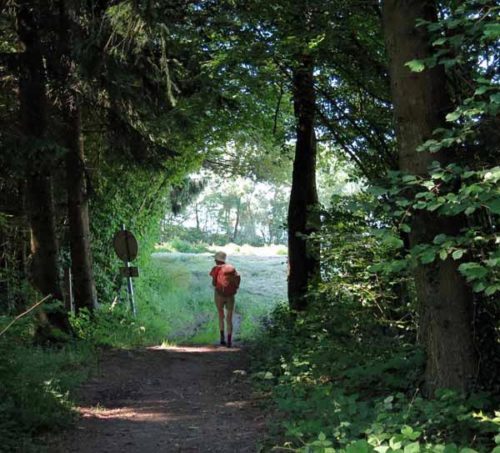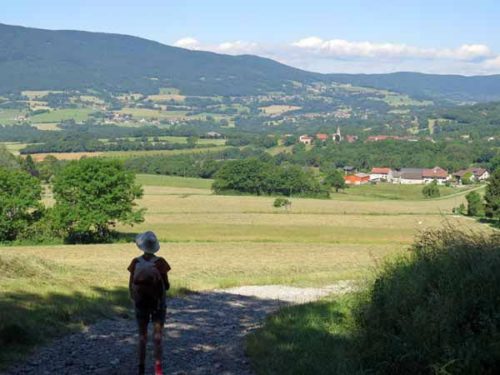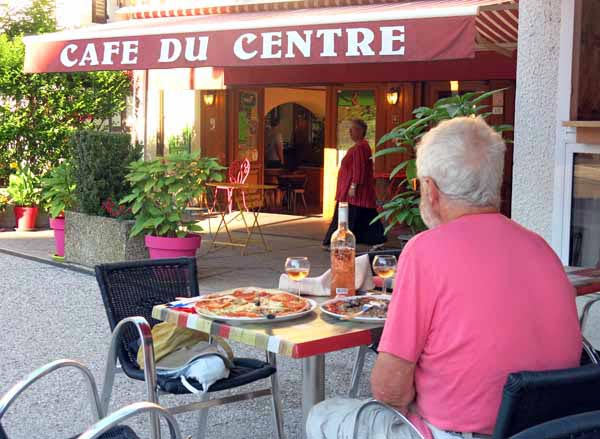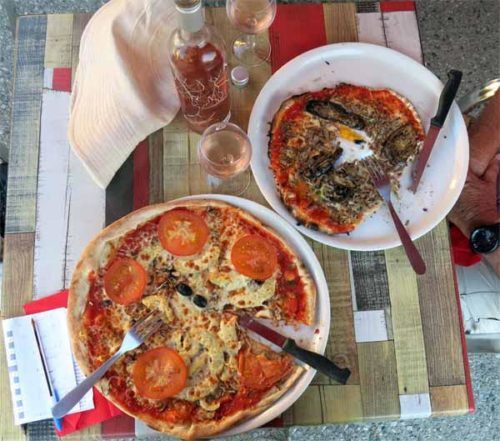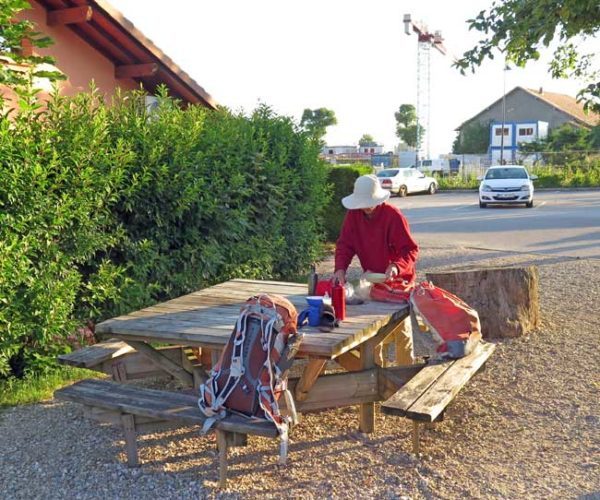
Tuesday, 28 June 2016
Distance 24 km
Duration 5 hours 40 minutes
Ascent 403 m, descent 611 m
Map 143 of the
Topoguide (ref. 650) Sentier vers Saint-Jacques-de-Compostelle : Genève – Le Puy
The night was starry and cold. We had to put on every garment we possessed, including two pairs of socks, before getting into our sleeping bags and draping our plastic capes over the top. Even then it was chilly.
Furthermore the so-called salad that we had eaten at McDonald’s did not seem to agree with me and I spent the night periodically trudging to the sanitaires, which fortunately were very close, but by morning I was quite well again.
As there was no prospect of breakfast in the village, we had a big helping of muesli before leaving the camping ground. There was a picnic table near the entrance, drenched in the first rays of sun, and we soaked up the warmth as we ate our dreary rations. I wore my new white cloth hat from Moulins for the first time.
Setting off, we went back the way we had come the evening before, under the A41 and up to Feigères, but after that we took the small D37 and walked determinedly in a south-westerly direction along a ridge, down and up past the village of Présilly.
It was pleasant walking in the mild morning sunshine and after an hour and a half we connected at last with the official way of Geneva, the GR65, at the high point called la Croix Biche.
We could have joined it earlier, as it went right past the gates of the camping ground, but we did not approve of its perambulations. Our way was much more direct.
The GR signs were a bit outlandish, we thought, not the simple red and white stripes that we were used to. However it was the first time we had seen a GR sign of any sort this year so we felt quite looked-after.
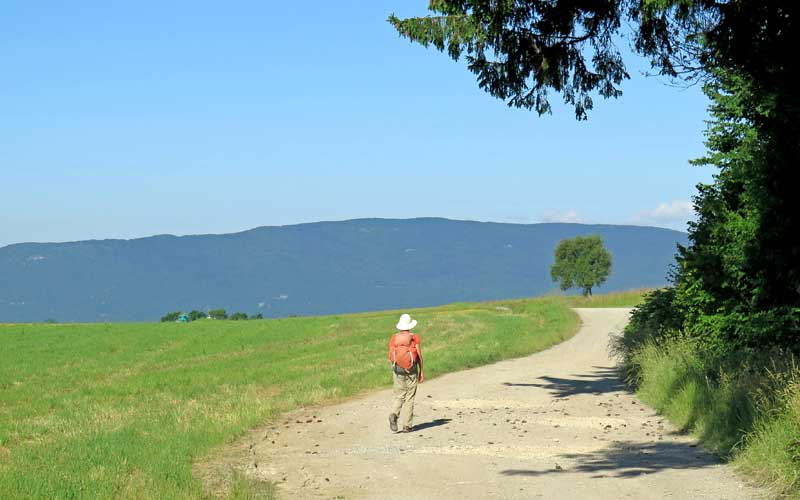


The track meandered along a grassy ridge shaded by patches of forest, from where the blue masses of the Jura looked close enough to touch, and then descended to the valley at the village of la Motte, which was picturesque but devoid of shops.
However at the edge of town there was a newly built pilgrim shelter with a tap, a picnic table, a noticeboard and an elaborate rubbish recycling system.

We stopped and ate the remains of the sandwiches we had bought on the train, washing them down with cold water. It was only slightly reviving.
As soon as we had climbed out of the valley, we found ourselves crossing an airy expanse called the Balcon du Léman.
After a while the GR descended through a tunnel of greenery and turned at the edge of the wood, but we decided to keep going down the slope to the village of Marlioz and rejoin the track at Contamine-Sarzin, whose slender church spire could be seen below us across the fields.
This track was still suffering the after-effects of the disastrously wet spring, and were reminded of our struggles in Burgundy as we picked our way past ruts full of grey, sucking mud.
After Marlioz the road was bitumen and we soon found ourselves back on the GR.
We continued along this agreeably flat road until instructed to deviate by a GR sign, after which the path began climbing relentlessly towards a sharp cone called le Mont. Checking the map, we realised that we had gone wrong – we had missed another turning sign hidden in the long grass. This was a relief, as we had no wish to conquer peaks just for the sake of it, so we turned downhill on a stony side track through a forest.
This brought us onto the D181 at a bridge over a deep ravine. According to our map, there was a path along this ravine leading straight to Frangy, our destination for the day. The GR meanwhile had veered off in the direction of Chaumont, high up on the other side of the ravine.

Hunting around, we found a likely looking path through the scrub on the lip of the gorge, but after a while it began to turn downwards and we saw the full horror of what lay below – a series of huge plunging slabs of rocks with no visible way between them. The river itself was frighteningly far down. It did not take us long to decide that the road was a better way to go, especially for us with our cumbersome packs.
I was feeling irritable from tiredness and lack of food, but fortunately it was only about three kilometres, through the perched village of Musièges, before we came down steeply to the outskirts of Frangy.
Seen from above it was surprisingly industrial, with trucks rumbling to and fro amongst raw-looking factories and shops, some of them warehouses selling local wines and cheeses (Frangy’s claim to gastronomic fame is its Roussette de Savoie wine).
As soon as we left this new estate and crossed a bridge, everything became old and run-down. The camping ground was the first thing we saw, and it looked pleasant enough, with a rustic lawn and flower beds in front of the building.
Nobody answered our knock so we went around to the campsite area at the back. This was a sorry mess of decrepit caravans and mobile homes, all of which were empty at this hour.
We realised later that they were occupied by people who were living cheaply here while working in the town – it was a sort of outdoor flophouse. We seemed to be the only genuine campers.
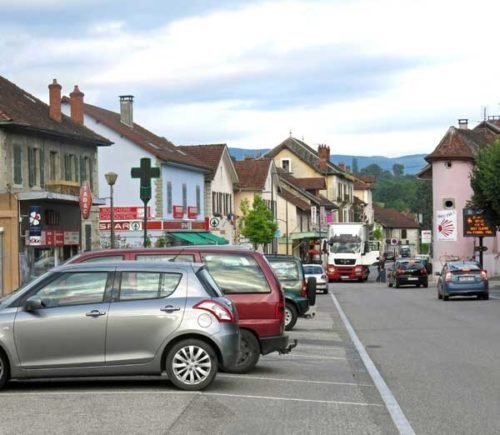
We put up our tent on a spot of grass in the shade of an ash tree, a small corner of beauty in the dusty, rubbish-strewn yard. The ablutions block was a ramshackle shed with an unlockable door. An old crone in a housecoat appeared from the house with a mop and bucket and began slopping dirty water around the floor, until Keith went with her to the office to pay, giving me the chance to have a shower.
It was rather primitive so I did not stay long, and decided to wash my clothes in the adjoining room, which had a basin and a cracked mirror hanging from a nail, as well as various toiletries belonging to the unfortunates who lived here.
The water from the wash basin leaked through a crack onto my feet in a disgusting way, but eventually we were as clean as we were going to be, and decided to go into the town, which was a good kilometre away. We were in low spirits, dragged down by the general air of deprivation and disorder.
We set off at about
By the time we got to the church, with its odd spire like a cocktail onion on a skewer, we had only seen two shops, neither of them interesting, and we were worried that there would be no more, but just around the bend we came upon a magnificent bar, le Café du Centre, with a terrace full of tables and people.
Further down there was a whole street of shops. Keith went to buy croissants while I sagged into a chair, and when he came back we had our first coffee of the day, in fact our second breakfast, at 4:30 pm.
The barwoman had a massive body like a ship in full sail, but her face was sweet and she moved with surprising grace around her little realm, attending to her flock.
It was an indescribable delight after a long day of austerity, and we cheered up immediately.
Next to the bar was a pizzeria, closed at that moment, but which the barwoman assured us would be open this evening.
After that we went back to our tent and had a rest in the shade, while the occupants of the caravans and mobile homes drove in one by one from work and ate their solitary take-aways, fiddling with their phones. I hoped they all had homes to go to at the weekend.
At 7:30 we walked back to town and sat down outside the pizzeria.
We asked the man if we could have a bottle of rosé by way of apéritif, but he said it would be illegal. However as soon as we had ordered our pizzas, it became legal. Such is the mysterious law in France. For the first time in this country, we got a bottle with a screw top instead of a cork.
The pizzas were delicious – a moussaka and a primavera, which we shared – and we returned to the camping ground in good spirits, having found out that the wonderful bar opened at 6 o’clock in the morning.
Previous day: St-Julien-en-Genevois to Neydens


